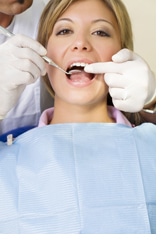Your Mouth is a Repository for Bacteria that Harm all Parts of the Body.
 Only 44 percent of American adults get regular oral care. No wonder more and more people with toothaches are showing up in emergency rooms across the country.
Only 44 percent of American adults get regular oral care. No wonder more and more people with toothaches are showing up in emergency rooms across the country.
That figure rises with age. Only half of people 65 and older have had dental care within the last year. And 23 percent haven’t been to a dentist in the past five years!
Gum disease is second only to the common cold as the most prevalent infection in this country. The first stage, gingivitis (or inflammation of the gums) is caused by plaque—sticky deposits of bacteria and food particles that adhere to the teeth. As gums swell with inflammation, pockets form between teeth and trap more plaque and bacteria.
Lack of regular cleaning not only means more gum disease but also predicts diabetes and heart disease. One obvious culprit is our great American sweet tooth.
Studies show that gum disease can begin within days of upping your sugar intake. “Clearly, the dental alarm bell has an extremely low threshold of activation,” says Philippe P. Hujoel, DDS, at the University of Washington School of Dentistry.
A high-carbohydrate diet is often the root of the problem as “fermentable carbohydrates” (sweets and high-glycemic carbs) start breaking down in the mouth. Sugars (in candy, cakes, cookies, doughnuts, and soft drinks, as well as sticky fruits like raisins) and fermentable carbs (in high-glycemic foods like pasta, potatoes, and white bread) lower the acidity level of dental plaque, initiating decay. And they cause spikes in blood sugar levels.
Abnormal blood sugar metabolism can lead to a variety of problems ranging from Alzheimer’s disease to pancreatic cancer. New evidence now links sugar intake with weakened immunity, heart disease, high blood pressure, cancer, obesity, metabolic syndrome and Type 2 diabetes, aging, and more.
Dr. Ann Louise’s Take:
Even if you have a pearly white smile and pink, healthy-looking gums, a massive infection may lurk under a crown or in the empty spaces where you have had a tooth pulled. I know this all too well from personal experience.
“How many people know the consequences of housing the 40 anaerobic bacteria in implants, the 60 in root canals, or the 8 in cavitations (holes in the jawbones from pulled teeth)?” asks biological dentist extraordinaire Hal Huggins, DDS. Most of these bacteria are hidden even from the best dentists—and some infections don’t show on standard X-rays.
Oil pulling, a time-honored Ayurvedic technique, works wonders for deep pockets in the gums that harbor bacteria and inflammation-causing plaque. A 2007 study in the Journal of Oral Health and Community Dentistry found that this simple method reduces gingivitis by 52 to 60 percent and cuts plaque by 18 to 30 percent!
Just put about two teaspoons of oil (sesame, coconut, sunflower) in your mouth and swish it around your teeth and gums. The oil picks up microbes much the way a powerful magnet attracts metal bits. The longer you push and pull the oil through your mouth, the more pathogens are pulled free, so be careful not to swallow any. If you need to spit it out, you may do so, but keep at least two teaspoons in your mouth for about 20 minutes. Then, spit out the oil.
You will see that the oil will be rather foamy—a sign that you have pulled out pathogens. You can rinse with a large glass of water with 1/2 teaspoon baking soda and salt to remove any oily residue on your teeth. Then rinse a second time with another glass of plain water.
Oil pulling is a highly beneficial method of cleansing your mouth and detoxifying your entire body. Make this easy practice part of your daily oral care.
You can also improve gum health with CoQ10, which heals gum tissue faster than any other nutrient I know. Japanese research shows that taking 30-90 mg daily is extremely helpful with bleeding gums, deterioration of the gums, and loosening teeth. Your heart will thank you, too. I personally recommend a daily dose of 100 mg.
Sources:
http://www.ncbi.nlm.nih.gov/pubmed/19722795
http://uwnews.org/article.asp?articleid=50669
http://www.ncbi.nlm.nih.gov/pubmed/19737135






Thanks Ann Louise. I love it when you share your wealth of knowledge. Great job!
Eco dent makes a fabulous healing mouthwash that has COQ10 and essential oils – all chemical free. It works wonders. It is also designed for wound healing. If I am starting sinus problems – this knocks it right out!
This is just brilliant, thank you so much for the info Ann Louise. I will definately practice this suggestion and also pass it on to all of my friends!
Thank you for this information, Ann Louise. We all need to be reminded of how important good dental health is.
Thank you for this imformation. It’s timely for me asI just had yet another tooth pulled. I will definitely try this. I get my teeth cleaned every 3 months, I floss twice a day and am still loosing teeth.
Jan, try the oil pulling and see how that works for you. But if you are still have problems with your teeth in spite of oral care it could be indicative of a mineral imbalance. You might want to get your minerals tested, Unikeyhealth.com has a hair test that gives some good insight into your metabolism and what supplements and foods you should be eating.
Will olive oil work as well?
Yes olive oil will work —
I use anoral irrigator with 1/2 listerine and 1/2 warm water. Could also use hydrogen peroxide. My hygenist says that it will get below the gum line bacteria which rinsing will not. What do you think about oral irrigators? I do run chlorox through it once in a while as I understand bacteria can grow in the lines. I do notice that if my teeth hurt, if I use the oral irrigator the pain stops. Isn’t getting older fun!
Love those irrigators….Your advice is sound. Only thing, can’t use hydrogen peroxide if one has veneers…Otherwise, I agree 1000% Getting older is not for sissies, that’s for sure 😉
Dear Friends:
I would love to answer each and every single one of your queries, as I have done to the best of my ability, in the past. The popularity of this Blog has grown to the extent that I can no longer provide that service but I am in the planning stages of an Internet – TV show where you can call in and get those questions answered by me in person! Please stay tuned for this exciting development. I first must complete a new manuscript and then will make some exciting announcements. In the interim, may I suggest that if you have questions about products, call UNI KEY at 1-800-888-4353. The folks there are helpful and will direct you accordingly. If you are concerned about a particular health condition, then by all means check out the Testing Kits on my site which will help you to determine underlying causes. Thank you so much for your enthusiasm and interest!
What is reversal where teeth are concerned?
Can you heat coconut oil before you pull thru gums. I am having trouble with “solid” coconut oil?
Please reply.
Thank you.
Hi there! You could warm it I suppose, though the melting point for coconut oil is 76 degrees, so within second of putting it into your mouth, it will become liquid.